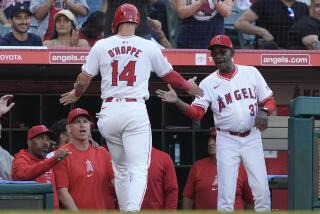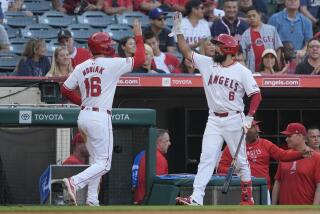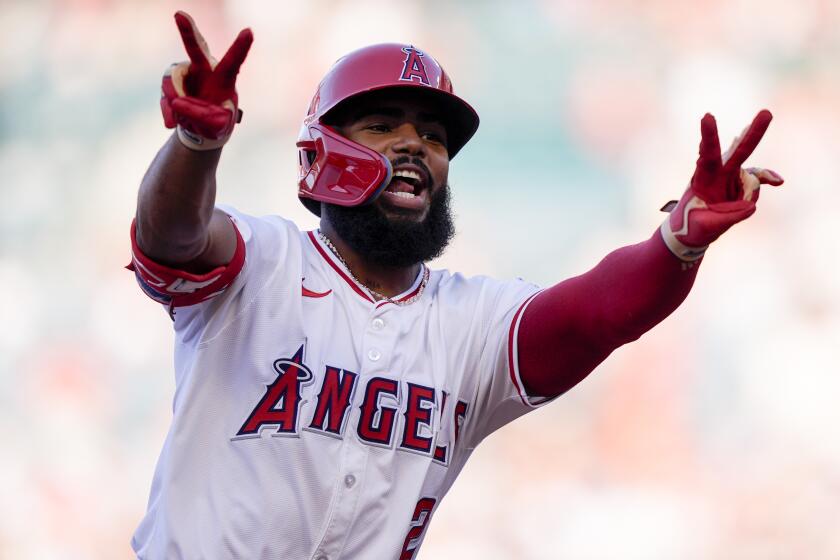Angels Born On the Fly
- Share via
Arizona Diamondback Manager Buck Showalter has had almost two years to prepare for Tuesday’s expansion draft.
Bill Rigney, the first Los Angeles Angel manager, had little more than two days to get ready for the 1960 draft.
“I was named manager on a Saturday afternoon in Los Angeles and [Wednesday] morning we held the draft in Boston,” said Rigney, who had been fired by the San Francisco Giants six months earlier. “I had been in the National League my whole life and I had no idea what to expect. I just needed a job.”
Rigney had no computer-generated mock draft scenarios, speed-gun numbers, home-to-first times, medical reports or psychological profiles when he and Angel General Manager Fred Haney--who had yet to celebrate his one-week anniversary on the job--met with representatives of the new Washington Senators to pick 28 players each for their fledgling American League franchises.
But Rigney clearly hadn’t wasted the little time he had and some of the information he did possess turned out to be pretty darn good.
On Sunday, he had flown to San Francisco at the invitation of Giant General Manager Chub Feeney and spent the day holed up in the team’s Candlestick Park offices, pouring over scouting reports.
“Chub must have felt sorry for me after firing me,” Rigney said, “because he let me go through all of their reports.”
Rigney left that day with names such as Jim Fregosi, Dean Chance, Bob “Buck” Rodgers and Fred Newman underlined on his list of available players. But Feeney had provided Rigney more than just access to the evaluations of scouts such as Charlie Fox and Carl Hubbell. His parting advice had given Rigney the will to draft them.
“Chub told me, ‘Look, L.A. is Fred’s town and he has to compete with the Dodgers,’ ” Rigney said. ‘ “He’s going to want to draft players with name recognition, but you want to manage that team next year and the year after and the year after. You’ve got no farm system, so make sure you get some prospects.’ ”
Rigney--named Angel manager after Haney’s close friend, Casey Stengel, turned down the job--soon discovered his determination was to be severely tested.
“We couldn’t land in Boston, so we had to land in New York and take the train up to Boston,” Rigney said. “It gave us a couple of hours to go over things.
“And every time I would point to the name of one of those kids, Fred would say, ‘[Bob] Cerv’ or ‘[Ted] Kluszewski’ or ‘[Eddie] Yost.’ Fred was an ex-manager and he had strong opinions about the players. I knew that and somehow we managed to compromise.”
The draft itself was less complicated--and probably more informal--than your average office rotisserie league draft these days.
Each of the eight American League clubs protected 25 players from its 40-man reserve list, submitting a list of 15 players available for selection. At least seven had to be on the major league roster before Sept. 1, 1960.
The clubs took turns drafting 10 pitchers, then two catchers, six infielders and four outfielders. Six additional selections filled out the rosters. (The Angels also made two minor-league selections; the Senators three.)
A coin was flipped before each category to determine who drafted first. The Angels had won three in a row when it came to the fourth position, outfielder. And the Angels won again.
“[American League President] Joe Cronin said, ‘Gee, you guys have won four in a row, it doesn’t seem fair,’ ” Rigney recalled. “I said, ‘It was your idea and what could be more fair?’ But Fred agreed to let them pick the first outfielder.”
The Senators drafted Boston’s Willie Tasby, the only player they picked all day that Rigney says he really wanted. Tasby wasn’t the next Mickey Mantle by any stretch, but he hit 49 homers, drove in 174 runs and hit .262 with three teams over the next four years.
“When the draft was complete, [Senator GM] Ed [Doherty] and [Manager] Mickey [Vernon] realized that they had one Yankee player and six Athletics and we had six Yankees and one Athletic,” Rigney said. “I guess they didn’t want to go back to their owner having to explain why we had six players from a team that finished first and they had six from the team that finished last.
“So, Fred says, ‘Oh, we’ll trade them a couple back.’ I said, ‘Bull, we will,’ but they made the trade anyway. We got [right-handed pitcher] Ned Garver, who lasted about half a season and shortstop Ken Hamlin, who never amounted to much.”
The Senators got two guys who had worn Yankee pinstripes--infielders Dale Long and Bud Zipfel--but not much in terms of building a foundation for the future. Both were out of baseball by the end of the 1963 season.
Fregosi, Chance, Newman and Rodgers--the kids Rigney had to fight to get--turned out to be what he calls “the guts” of the Angel organization.
Fregosi became a six-time All-Star at shortstop. Right-hander Chance won 20 games and the Cy Young Award in 1964. Catcher Rodgers was behind the plate for nearly 900 games as an Angel over nine years. And right-hander Newman had a 3.41 earned-run average in six years of pitching for the Angels.
“I had seen Jimmy [Fregosi] play in high school up in San Francisco, so he wasn’t a complete unknown, but Fred and I had never heard of Dean Chance,” Rigney said. “He was more interested in some of the veterans, but I showed him how many no-hitters [Chance] had in high school.
“I think it was the time he struck out 21 in a seven-inning game that did it. I mean, you’ve got to have a pretty good arm to strike out every guy you face, even in high school.”
In 1962--the Angels’ second season--Chance was 14-10 with a 2.96 ERA, Fregosi hit .291 and Rodgers drove in 61 runs and caught 155 games.
“It was the most enjoyable year I ever had in all my years of managing,” said Rigney, 78, who managed 17 years with the Giants, Angels and Twins. “We were leading the league on the Fourth of July and just 2 1/2 behind the Yankees on Labor Day.”
The Angels finished in third place, 10 games over .500. Rigney was named manager of the year and Haney executive of the year. Despite their draft-day battles, Rigney says Haney richly deserved the honor because of what he believes is one of the best trades in the club’s history.
“Fred made a great trade when he gave Cerv and [Tex] Clevenger back to the Yankees and got Lee Thomas and Ryne Duren,” Rigney said. “Thomas, of course, drove in [104] runs in ’62 and Duren combined with [Art] Fowler, [Dan] Osinski and [Jack] Spring to give us the best bullpen I’ve ever had.
“In fact, I don’t think I’ve ever seen a better one.”
Showalter and Tampa Bay’s Larry Rothschild might want to talk to Rigney, who is a special assistant with the Oakland Athletics, about his short speech the first day the Angels were together for spring training in Palm Springs.
“I told them we had the responsibility of breaking in a brand new uniform and starting a new tradition,” Rigney said, “but I also reminded them that they were very special because we had picked every player on that team. I wanted them to know we wanted them.
“And those guys the first couple of years really created something among themselves. When the lights went on in Hollywood, some eyes got pretty big and I was sure I could always find a team meeting in some bar. But it was a great time.”
One other thing Showalter and Rothschild might want to take note of: Six months after the 1960 expansion draft, doctors discovered Rigney had an ulcer.
More to Read
Go beyond the scoreboard
Get the latest on L.A.'s teams in the daily Sports Report newsletter.
You may occasionally receive promotional content from the Los Angeles Times.






